Overview of the nuances of connecting a private house to a central sewer
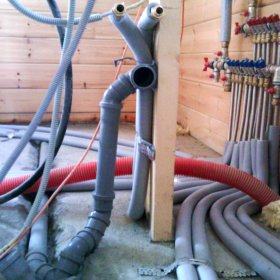
In the process of constructing a private house, its owner has to deal with the design and subsequent installation of communications. The absence of centralized communication networks in the construction area leaves the developer no choice - he will have to install an autonomous sewer. For those who build housing close to centralized networks, there is a choice - to equip an autonomous system or connect to the city sewer. As practice shows, the second option is most often chosen. Let's understand the advantages and nuances of independent connection of private development to a centralized system.
Content
Why is this option profitable?
Deciding to crash into a centralized sewage system, the developer receives certain advantages:
- The opportunity to significantly save on the purchase, installation and maintenance of an autonomous sewage system.
- The successful connection allows you to use the sewer line for a long time. The only condition is the timely payment of the necessary payments.
- No need to control the quantity and quality of wastewater.
All this makes the insert into the centralized sewerage system extremely attractive to most developers.
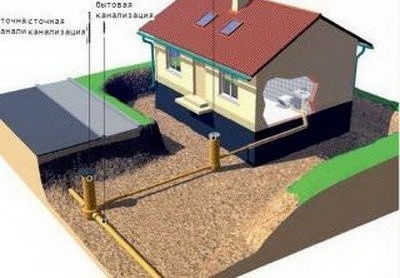
Connecting a private house to a centralized sewer system is a convenient and practical solution to the problem of water disposal
Where will it start right?
First of all, you need to determine the type of sewerage passing near the house. Depending on this, two possible connection types are distinguished:
- Separate. It is used in case of connection of storm and household sewerage of a private house. It is carried out separately in two systems.
- Mixed. It can be used in the presence of a mixed type pipeline. In this case, one common pipe is brought in, which crashes into the system.
You need to understand that the sewage system, which will connect the house with a centralized system, is financed by the developer. This can result in a decent amount. Those who wish to save may try to carry out the planned event during the planned modernization of the centralized branch. To do this, before starting work, turn to a water utility, where to offer your financial participation in such a modernization. If the decision is positive, the organization will take on part of the work, including design and connection, which will give significant savings. Another way to pay less is a collective tie-in with your neighbors. In this case, costs can also be reduced.
Independent insertion into the central sewer is a troublesome event.Those who do not like to run around instances can be advised to contact a company that provides such services. In this case, the developer will be spared the need to collect a package of permits and solve a number of organizational issues. In addition, the procedure for commissioning a new branch is greatly simplified. However, such services are not cheap and those who wish to save on them will most likely refuse.
Those who decide to tackle the issue on their own will need to collect the following documents:
- The plan of the site and the house on which the scheme for laying the sewer pipeline should be applied. It is carried out by a company specializing in surveying.
- Technical conditions of the new connection. Developed by an organization that provides sewer services.
- A project for connecting a branch to a centralized sewage system. The document is prepared by a specialist designer. The basis for it is the previously obtained situational plan and technical conditions.
- Coordination of the prepared project in the water utility and the Architectural Department. In parallel, a company is being approved, which will subsequently be involved in connecting a new branch.
Another important nuance. It is worth securing the consent of residents of neighboring houses to carry out construction work in the immediate vicinity of their sites. A document should be prepared and the signatures of the neighbors collected. If the pipeline passes through sections where networks of other organizations are located, for example, electric or thermal, and it is also planned to be carried out under the carriageway, additional permits will be required. If all these procedures seem too troublesome and there is a desire to conduct an unauthorized insert without collecting documents, you need to know that such actions require an impressive fine and forced dismantling of the pipeline at the expense of the developer.
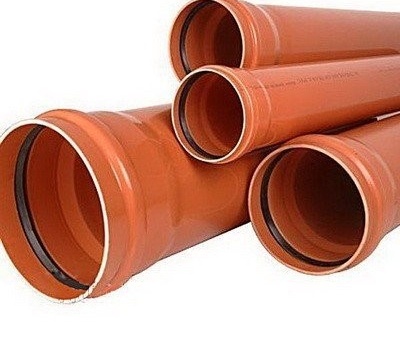
To equip the external sewerage branch, which will be stretched to the central highway, a special pipe should be used
How to equip the site before the tie-in?
Existing SNiPs clarify that permission to lay a pipeline to the central highway can only be obtained if there is a diversion sewer well nearby. A branch from the house should go through it. It should be borne in mind that the pipe leaving the private household should enter the well at a certain angle above the level of discharge. In addition, the pipe is laid to a certain depth. Its value depends on the level of soil freezing.
To determine the laying depth, you can use the values given in SNiP P-G.3-62, which vary depending on the area of development:
- For the northern part of Russia, they are about 3-3.5 m.
- For the middle zone of our country - 2.5-3m.
- For the southern regions -1.25-1.5.
These values are quite approximate. Everything is very individual and depends on the type of soil, terrain and nature of groundwater. In general, the average laying depth is 1-1.2 m, while the minimum value is 0.5 m, if measured from the upper edge of the pipe. When digging a trench, it must be borne in mind that its depth should be 5 cm greater than the estimated laying depth. Another important point is the slope of the pipe. With a slight slope, the wastewater will leave extremely slowly, which is fraught with clogging of the pipe. If the slope, on the contrary, is too large, the water will leave too quickly, not having time to wash off the grease and other impurities. It also provokes the appearance of blockages.
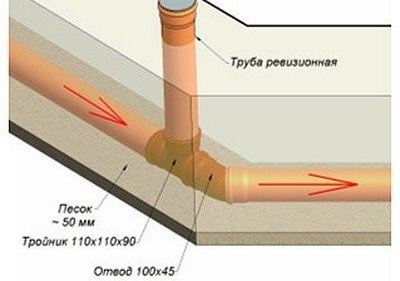
When installing the sewer branch before tapping into the central system, the required slope is observed. Over sharp bends of the pipe, an inspection well is installed
To avoid such troubles, sewer pipes lay with a bias 1-2 cm per linear meter.Another important point is the presence of turns on the track. Ideally, they should not be. If this is not possible, sharp turns should be avoided, “smoothing” them as much as possible. If necessary, turn the line 90 ° or more, you will need to equip the inspection well at the turning point. Also, experts recommend installing an additional inspection well in the case of a long sewer line. It will allow you to control the system.
The next step is digging a trench. It is important to choose a width that is sufficient for laying parts. It should be borne in mind that the outer pipe should have a larger diameter than the inner one. Most often, it varies from 150 mm to 250 mm. In the case of a collective tie-in, a 250 mm diameter pipe is taken, 150 mm part is used to equip branches to the yards. It should be borne in mind that in this case, an additional inspection well should be equipped at the input site of each yard. When choosing the width of the trench, you need to focus on such indicators: for a part with a diameter of 110 mm, the width of the pit should be at least 60 cm.
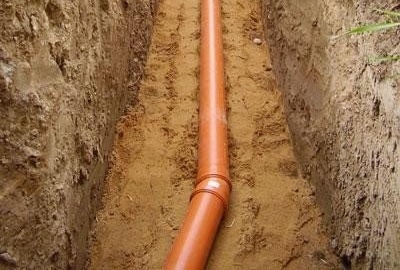
The bottom of the trench is rammed and a sand or gravel cushion is laid on it, on which a sewer pipe is laid
The bottom of the dug trench is leveled and well rammed. Then you can start to prepare a pillow. It consists of gravel or sand, the layer of which is about 10-15 cm. It is not necessary to seal the pillow all the way, but from the side of the incoming pipe and two meters from the well, this is mandatory. Under the bells of sewer pipes, pits should be made. Now you can lay the pipeline. The operations are performed in the following sequence:
- Pipes are laid in a trench from the slope with the socket down.
- The smooth edge of one part and the bell of the second are cleaned of dirt.
- The ring in the socket and the smooth edge are lubricated with special grease. It can be a silicone compound or a regular liquid soap.
- The length at which the part should be inserted into the bell is measured, and risk is applied.
- The pipe is fully inserted into the socket.
Thus, the entire pipeline is laid. After its installation, the slope angle is checked, only after that they start backfilling. They start with a layer of sand, which should cover parts to a height of about 5-10 cm. Then everything is very abundantly spilled with water. It is necessary that the sand sank well. The settled material will reliably protect the pipeline from sagging soil and stones, preventing them from damaging the pipes. This will significantly extend the life of the sewer line. Now you can fill up the soil.
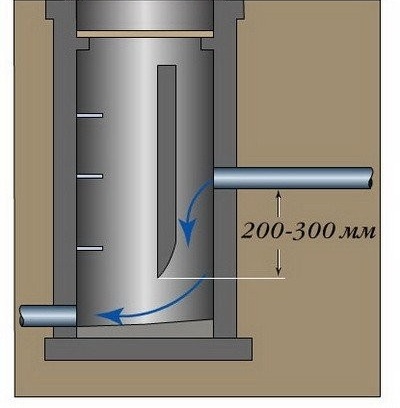
According to the requirements of SNiPs, a pipe leaving a private building must enter the overflow well at a certain angle above the discharge level
Actually the preparatory work on this is finished. Then it remains only to connect a new branch to the central sewer. This procedure can only be performed by employees of a specialized company, which was agreed upon in advance when approving the project. After the connection, it is necessary to notify the water utility about the readiness to launch a new line. The service company accepts the completed project into operation, and also enters into an agreement with the owner of the house for the collection of wastewater.
Solving the problem of storm sewers
Arrival of a storm - an obligatory stage of site planning. By connecting the outlet of the storm sewer to the household collector, it will not be possible to solve the problem of storm drains. Such a “solution” significantly increases the load on the network, which can provoke even greater problems. There are two options for arrangement:
- Installation of a drainage system private household with the removal of storm drains in a specially designed for this tank. On the site is equipped with a tank for collecting melt and rainwater.It can subsequently be used for watering the garden and other household needs. Optionally mount a natural filter in front of the tank. They can serve as a small sump.
- Direction of drains into a storm central sewer. It can be carried out only with permits. A pipe with storm drains is routed to the centralized system manifold.
Connecting a private home ownership to a centralized sewage system, if desired, can be done in various ways. But in any case, the participation of specialists is required. The only difference is at what stage they will connect.
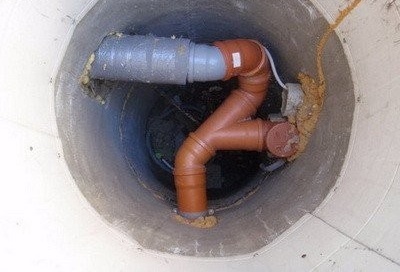
When arranging a sewer branch, audit wells are necessarily mounted, making it possible to control the system
Those who want to get by with minimal costs, deal with training on their own. The rest seek help from specialists who take care of all issues related to the organization and implementation of work.



2 comments